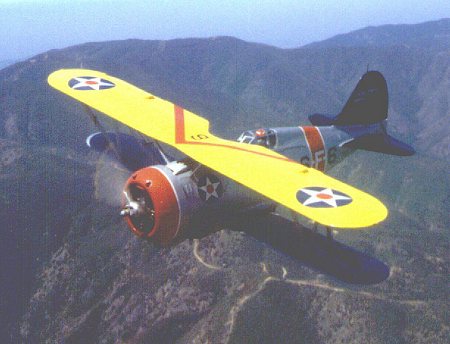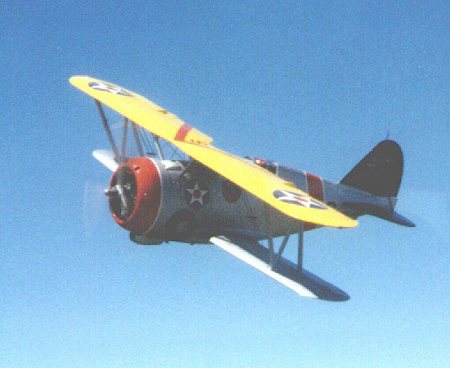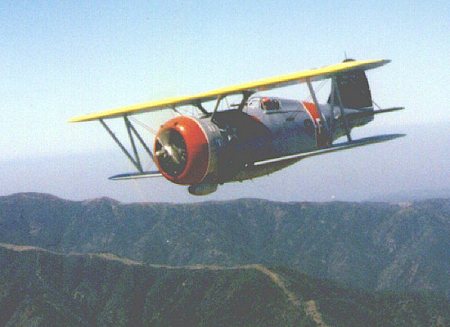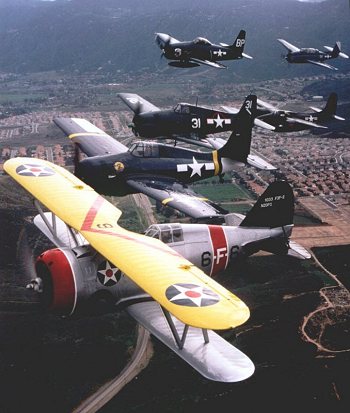
|
KIT: |
Accurate Miniatures 1/48 F3F-1 |
|
|
KIT # |
|
|
|
PRICE: |
$29.98 |
|
|
DECALS: |
Enough to do almost any F3F-1 |
|
|
REVIEW & PHOTOS BY: |
||
|
NOTES: |
Images are of full scale replica F3F-2 |
|

|
HISTORY |
The F3F series of carrier fighters were not the first products of the "Iron Works" Grumman Aircraft Corporation, though it was the first to become "famous," due to its appearances before the war at such events as the Cleveland Air Races and its appearance in the 1940 Warner Brothers movie, "Dive Bomber," a major hit of the day. The FF-1 two seater went aboard "Lexington" in 1933 with VF-5B "Red Rippers," and the F2F-1 served with the "Flying Chiefs" of VF-2 from February 1935 until they exchanged their airplanes for F2A-2s in November 1940.
The F3F series was the culmination of that entire series of combat aircraft; to many, it represents the zenith of the biplane fighter. It certainly represents the high-point of pre-war Navy fighter aviation. All of the great fighter leaders of the Second World War, including such as David McCampbell, John Thach, Jimmy Flatley and Butch O'Hare flew the airplane, which introduced them to such then-advanced items as retractable landing gear and a controllable propeller.
The F3F-1 began life as a development of the F2F-1, with a longer fuselage to cure the directional instability and provide acceptable spin behavior over the earlier airplane, and larger wings to provide increased maneuverability. Three and a half months before the scheduled delivery of the first F2F-1, the F3F-1 was contracted for, with the first one flying a month after the "Flying Chiefs" had taken their "flying barrels" aboard "Lexington," while the remainder of the 54 F2F-1s were still on the production line.
The XF3F-1 was lost during terminal dive tests on March 22, 1935, killing chief Grumman test pilot Jimmy Collins. The second prototype - carrying the same BuNo - was lost May 13 when it was unable to recover from a flat spin that developed during a 10-turn right spin demonstration at Anacostia. A third XF3F-1 was built using components salvaged from the second, and Navy trials commenced on July 10, 1935. Third time lucky, the airplane came through the rigorous test program rapidly and with high marks.
54 F3F-1s were ordered on August 24, 1935, equipped with the first hydraulically-controlled propeller on any Navy aircraft. The F3F-1 was appreciably more maneuverable than its predecessor, though intentional spinning was prohibited. Interestingly, though it was heavier than the F2F-1 and powered by the same engine, the F3F-1 had similar performance statistics and was even some 12 m.p.h. faster at sea level. Deliveries to the squadrons began in January 1936 and were complete in August of the same year.
The F3F-1 served with front line squadrons until it was replaced by the F2A-1 in VF-3 in early 1940; the F4F-3 replaced it with VF-7 later that year. All of the survivors were lost as trainers during the Second World War.
|
THE KIT |

The other week when I called to check on the status of these kits, Bill Bosworth told me, "I think this is the best kit Accurate Miniatures has ever made, and just might be the best one we ever do." Bill's a helluva nice guy, but I took that as a bit of "hype," and made sure to follow it with lime and salt as I swallowed it.
However...
On opening the box and examining the contents, it's clear that this in fact is the best kit Accurate Miniatures has done to date. As to it being the best they'll ever do... I hope it becomes their new benchmark, and that they beat it. Not that that is going to be easy.
The injection molding of this kit is so sharp, one could almost think it was high-quality resin molding.
One thing we serious biplane modelers look at is the fabric effect and the rib detail on the wings. If it's the usual "hills and valleys," we're disappointed. Real fabric-covered wings don't look like that. They're tight and flat, and the only thing you can really see of the ribs under the fabric is the rib tape on top of it. That's the way it should be, and of all the biplane kits made, the only ones that come close to that are the Blue Max Sopwith Camel, S.E.5a, and Bristol Fighter... until now. The wings of the F3F-1 are very likely the very best fabric-covered wings ever done in an injection-molded kit. They're one piece, upper, lower right, lower left, with trailing edges you could cut your finger on if you're not careful.
This means that the mounting holes for the bomb racks under the lower wings and the gun camera on the upper wing can't be flashed over to be left alone if you don't want them. However, the airplane nearly always had the gun camera and the bomb racks, if not the bombs; cutting the bombs off the racks is easy. Here is my one complaint about this kit - I wish they had provided the practice bomb dispenser rather than a full-size 100-lb. bomb, which was seldom carried by the airplane, while the dispenser is there in nearly every photo you see of the F3F-1.
The fuselage is stunning in its detail. The lapped aluminum sheets that formed Grumman construction are done perfectly, with small rivet heads that are in scale. This is an airplane built before flush riveting became de rigeur in high-speed aircraft construction, so it is right to have these. This effect is as well-done as the Tamiya representation of the same construction methodology in the F4F-4 kit.

The cockpit is simple, as I can attest after studying the 1:1 replica F3F-2 that lives out at The Air Museum, "Planes of Fame," in Chino. Everything that cockpit has is represented here. There will be no need to wait for an aftermarket manufacturer to produce a resin cockpit before proceeding with this model. The canopy glass is a bit thick, but clear; since it is almost always slid back on the open position, it will present no problem for seeing the cockpit. A photo-etch lap belt is provided - the U.S. Navy did not use shoulder harnesses at this time.
For those who are put off by biplanes because of the difficulty of aligning the upper and lower wings, this kit solves that problem with cabane struts that are molded integral to the fuselage halves. The instructions say that assembling the wings starts with attaching the upper wing, which will then provide positive alignment for the interplane struts. This is a biplane even a jet modeler will have no problem assembling.
Additionally, Accurate Miniatures has provided photo-etch interplane rigging. Let me tell you, even we diehard biplane modelers consider rigging the things the hardest part of the process. I sincerely hope that other manufacturers of biplane kits will look at what Accurate Miniatures has done here, and at what Tamiya has done on their Swordfish, and that photo-etch rigging becomes commonplace in the future. Who knows? Biplanes could become a mainstream modeling genre with this addition.
57 F3F-1s were produced, and with the decal sheet provided here, a modeler can make any one of them, even the XF3F-1 (as to which XF3F-1 one is making, well... ) I do wish they had provided the different-colored section marking stripes as decals, but this is not really a problem. If one does not want to paint them on, it is not hard to obtain solid-color decal sheets that can be cut to fit.
The instructions point out that U.S. Navy airplanes had their upper wing painted "orange-yellow," NOT "chrome yellow" in this period. As a long-time builder of "Golden Age" U.S. Navy aircraft, allow me to recommend that you use Gunze-Sanyo's "Orange-Yellow" for this; it is dead-on for the correct color.
|
CONCLUSIONS |

I thought the Accurate Miniatures TBF Avenger was one of the best plastic kits I had ever seen when it first came out. When the SBD series arrived, I was sure they were the best injection-molded kit I had seen. Both of these now have to fight it out for #2 behind this kit. The F3F-1 is a serious contender for the title of Best Injection-Molded Kit Ever Made. Was it worth the wait? YESSSSSSSSSSS!!!!!!!!
Thanks to Accurate Miniatures for providing the review kit.